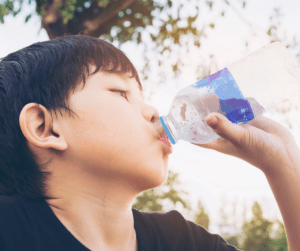Eating well is a big part of kids growing strong and staying healthy—but figuring out what (and how much) to feed them isn’t always easy. Nutritional needs for children change as they get older, so we’ve put together a guide to make balanced eating understandable at each stage.
Benefits of healthy eating in childhood include:
- Developing strong bones and teeth.
- Preventing constipation and other stomach issues.
- Supporting brain development and sustained energy.
- Building and repairing muscles.
- Promoting long-term heart health and reducing their risk of diseases.
Nutrition for Toddlers and Preschoolers (Ages 1-5)
Young children grow in bursts, so it’s completely normal for their appetite to change—from eating a lot one day to very little the next. Early exposure to a variety of foods helps build lifelong healthy habits, so as long as you’re offering more than just starchy, beige favorites like chicken nuggets, they’ll naturally begin to explore.
Key Nutrients and Foods to Focus On
- Calcium: Whole milk is a key source after age 1, but other options include lactose-free milk, soy milk and tofu. Some fortified foods—like orange juice, cereals or oatmeal—can be good additions once your child is ready.
- Fiber: Slowly introduce small amounts of fiber-rich foods like soft fruits (such as peeled apples, bananas and pears), well-cooked vegetables (like carrots, sweet potatoes or zucchini), soft beans (such as black beans or lentils) and whole grains.
- Protein: Stick with soft, easy-to-chew foods like scrambled eggs, yogurt and finely shredded or ground meats. Nut butters are great too—just serve them thinly spread to reduce choking risk.
- Fat: Healthy fats are essential at this age. Offer whole milk, avocados, olive oil and nut butters while avoiding fried or ultra-processed foods.
Recommended Daily Servings for Toddlers and Preschoolers
Note: Portions may vary based on your child’s appetite and growth needs—especially for toddlers.
- Vegetables: 1 to 1½ cups for ages 2–3; 1½ to 2½ cups for ages 4–5
- Fruits: 1 to 1½ cups for ages 2–3; 1 to 2 cups for ages 4–5
- Grains: 3 to 5 ounces for ages 2–3; 4 to 6 ounces for ages 4–5
- Proteins: 2 to 4 ounces for ages 2–3; 3 to 5 ounces for ages 4–5
- Dairy: 2 to 2½ cups
Source: https://www.myplate.gov/
Nutrition for Grade-Schoolers (Ages 6-12)
As children become more independent, they start making more of their own food choices—especially during school hours. Many kids in this age group already consume more than enough sugar, fat and sodium, so it’s important to limit processed snacks and fried foods at home. Packing your child’s lunch or reviewing the school menu together can help encourage smarter decisions.
Key Nutrients and Foods to Focus On
- Calcium: Milk, cheese and yogurt are top sources, but fortified plant-based milks, tofu, leafy greens and calcium-enriched cereals can also help meet daily needs.
- Fiber: Aim for whole fruits instead of juice, and choose whole grain versions of bread, pasta and cereals whenever possible.
- Protein: Include lean meats, eggs, yogurt, beans, rice and nut butters, while limiting processed meats that are high in sodium and unhealthy fats. This is especially important for teens who are physically active or involved in sports.
- Fat: Should make up less than 30% of daily calories, with most coming from healthy sources like low-fat dairy, avocados and olive oil.
Recommended Daily Servings for Grade-Schoolers
Note: These numbers can vary based on individual activity level and growth patterns.
- Vegetables: 1½ to 2½ cups
- Fruits: 1 to 2 cups
- Grains: 4 to 6 ounces
- Proteins: 3 to 5.5 ounces
- Dairy: 2½ cups
Source: https://www.myplate.gov/
Nutrition for Preteens and Teenagers (Ages 13-18)
As puberty begins, calorie needs rise to support growth, hormonal changes and physical development. It’s important that this increase comes from nutrient-dense, balanced meals—not just fast food or snacks with little value. Many teens already get too much saturated fat from processed foods, so now’s the time to reinforce healthy habits that will carry into adulthood.
Key Nutrients and Foods to Focus On
- Calcium: Continue offering calcium-rich and calcium-fortified foods like yogurt, cheese, tofu, leafy greens, oatmeal and fortified cereals to support bone growth.
Iron: Iron-rich foods—such as lean meats, beans and spinach—are especially important for teenage girls to help offset losses from menstruation. - Protein: Provide a variety of sources, including lean meats, fish, eggs, beans and dairy that support muscle development and energy.
- Fat: Encourage healthy fats from avocados, nuts, and olive oil to fuel growth and daily activity.
Recommended Daily Servings for Preteens and Teenagers
Note: Nutritional needs can vary significantly due to growth spurts and increased physical activity.
- Vegetables: 2½ to 4 cups
- Fruits: 1½ to 2½ cups
- Grains: 5 to 8 ounces
- Proteins: 5 to 6½ ounces
- Dairy: 3 cups
Source: https://www.myplate.gov/
What About Kids’ Water Intake?
Water makes up more than half of a child’s weight and plays a vital role in nearly every bodily function. Encourage your child to stay hydrated throughout the day—not just when they feel thirsty. Children ages 4 to 13 typically need about 5 to 8 cups of water a day, while teens may need more—especially during physical activity or in hot weather. Simple ways to support better hydration:
- If your child isn’t a fan of plain water, try adding a splash of lemon or infusing it with other natural fruit flavors.
- For active kids—especially those involved in sports or playing outside in warm weather—make sure they’re drinking water before, during and after physical activity.
How Can You Incorporate Healthier Eating Habits for Kids?
- Cook more meals at home: Takeout and restaurant meals often contain extra sugar, sodium and unhealthy fats. Cooking at home—even just a few times a week—can make a big difference. Large batches or meal prepping can help simplify busy schedules.
- Get kids involved: Let children help with grocery shopping and meal prep. It’s a great opportunity to teach them about different foods, how to read nutrition labels and make healthy choices.
- Keep healthy snacks on hand: Making nutritious options easily accessible helps steer kids away from soda, chips and sweets.
- Be mindful of portions: Avoid pressuring kids to clean their plates, and don’t use food as a reward or bribe. Let them listen to their own hunger and fullness cues.
- Make mealtimes about connection: Sharing meals as a family gives kids a safe space to talk about their day. These conversations can relieve stress and support their self-esteem as they age.
Looking for healthcare that supports your child’s full physical well-being? Carolina QuickCare offers comprehensive services—including physicals—to help keep them healthy at every stage.
Pair Healthy Eating Habits With Expert Health Care
Good childhood nutrition lays the foundation for lifelong health—but it’s only part of the picture. At Carolina QuickCare, we’re here with timely, quality support for their well-being whenever needed. Walk into a nearby location or reserve a visit spot at a time that works best for your family.




Recent Comments